Air Circuit Breaker (ACB): Construction, Operation, Types and Applications
Circuit Breaker
A circuit breaker is a device, which can
- Make or Break a circuit manually or by remote control under normal conditions
- Break a Circuit automatically under fault conditions (like over current, Short circuit, etc.)
- Make a circuit manually or by remote control under fault conditions
A circuit breaker is used for switching mechanism and protection of the system. Other associated devises and components are also used for this purpose associated with circuit breakers like fuses, relays, switches etc. Circuit breakers are widely used in industries as well as Power system for controlling and protection of different parts of the circuit like switchgears, Transformers, Motors, Generators/Alternator etc., which leads the system stable and reliable.
There are different types of circuit breakers available in the market and we will discuss one by one in detail.
Air Circuit Breaker:
The type of circuit breaker, which operates in air (where air-blast as an arc quenching medium) at atmospheric pressure, is known to be an Air Circuit Breaker. Air circuit breaker has completely replaced by oil circuit breaker. In different countries, still it is a preferable choice to use an Air circuit breaker up to 15KV because, there is no chance of oil fire like in oil circuit breaker.
Construction of Air-Circuit Breaker
Air Circuit Breaker Construction (ABB EMax Low Voltage, Current Limiting Air Circuit Breaker and Selective (Non-Current Limiting) Air Circuit Breaker)
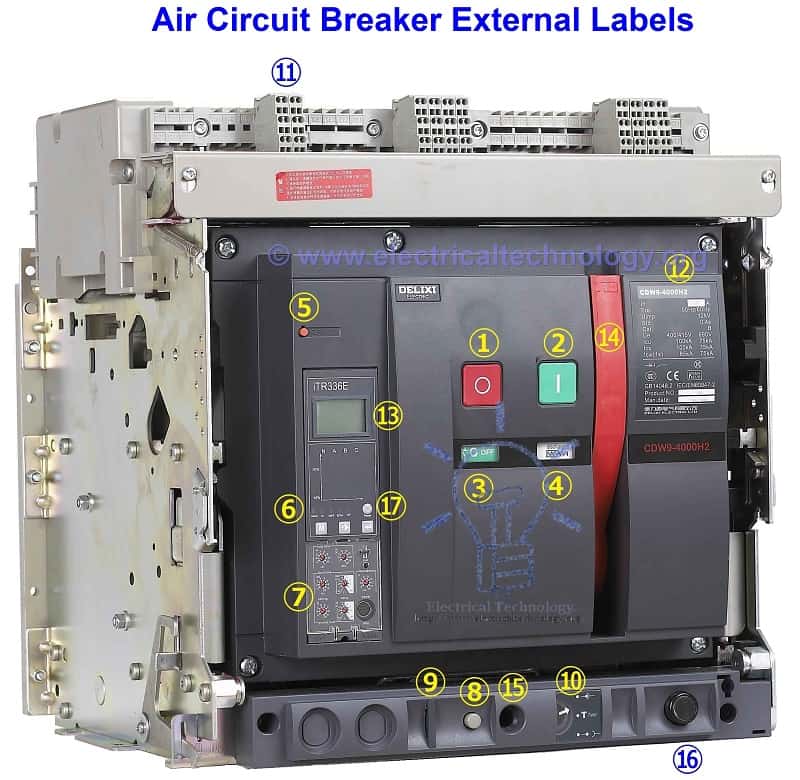
- OFF button (O)
- ON button (I)
- Main contact position indicator
- Energy storage mechanism status indicator
- Reset Button
- LED Indicators
- Controller
- “Connection”, “Test” and “isolated” position stopper (the three-position latching/locking mechanism)
- User-supplied padlock
- Connection “,” Test “and” separation “of the position indication
- Connection (CE) Separation, (CD) Test (CT) Position indication contacts
- Rated Name Plate
- Digital Displays
- Mechanical energy storage handle
- Shake (IN/OUT)
- Rocker repository
- Fault trip reset button
Internal Construction of Air Circuit Breaker (ABB EMax Low Voltage Current Limiting Air Circuit Breaker and Selective (Non-Current Limiting) Air Circuit Breaker)
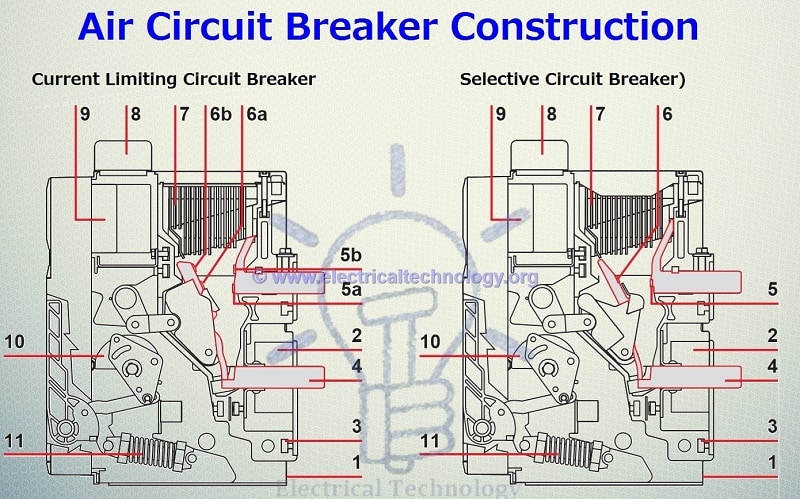
1. Sheet Steel Supporting Structure
2. Current Transformer for Protection Trip Unit
3. Pole Group insulating box
4. Horizontal rare terminals
5a. Plates for fixed main contacts
5b. Plates for fixed arcing Contacts
6a. Plates for Main moving contacts
6b. Plates for Moving Arcing contacts
7. Arcing Chamber
8. Terminal box for fixed version – Sliding Contacts for withdrawable version
9. Protection Trip Unit
10. Circuit breaker Closing and Opening Control
11. Closing Springs
Principle of Operation of Air Circuit Breaker:
The working principle of Air Circuit breaker is rather different from other types of circuit breaker. The main aim of circuit breaker is to prevent reestablishment of arcing after current zero where the contact gap will withstand the system recovery voltage. It does it same work, but in a different manner. During interruption of arc, it creates an arc voltage instead of supply voltage. Arc voltage is defined as the minimum voltage required for maintaining arc .The circuit breaker increases the voltage in three different ways:
- Arc voltage can be increased by cooling arc plasma. As soon as the temperature of arc plasma motion of particle in arc plasma is reduced, more voltage gradient will be required to maintain the arc.
- By splitting the arc into a number of series will increases the arc voltage.
- Arc voltage can be increased by lengthening the arc path. As soon length of arc path is increased the resistance path will increase more arc voltage is applied across the arc path hence arc voltage is increased.
It is operated within voltage level up to 1 KV. It contains two pairs of contact. The main pair carries the current and the contact made of copper. An additional pair of contact is made of carbon. When the breaker is opened, the main contact opens first. During opening of the main contact, the arc contact remains in touch with each other. The arcing gets initiated when arc contacts are separated. The circuit breaker is obsolete for medium voltage.
Types of Air circuit breaker:
- Plain air circuit breaker or Cross-Blast Air Circuit Breaker
- Air blast circuit breaker
Plain air circuit breaker or Cross-Blast Air Circuit Breaker:
The circuit breaker is fitted with a chamber surrounding the contact. The chamber is known as “arc chute”. The arc is made to drive in it. The arc chute will help in achieving cooling. Arc chute is made from some refractory material. The inner walls of arc chute are shaped in such a way that arc is not only forced into close proximity, but will drive into the serpentine channel projected on arc chute wall.
The arc chute is divided into a number of small compartments by using metallic separation plates. Metallic separation plates are arc splitters and each of small compartments behave as a mini arc chute. Initial arc will split into a series of arcs this will make all arc voltages higher than system voltage. They are preferable choice in low voltage application.
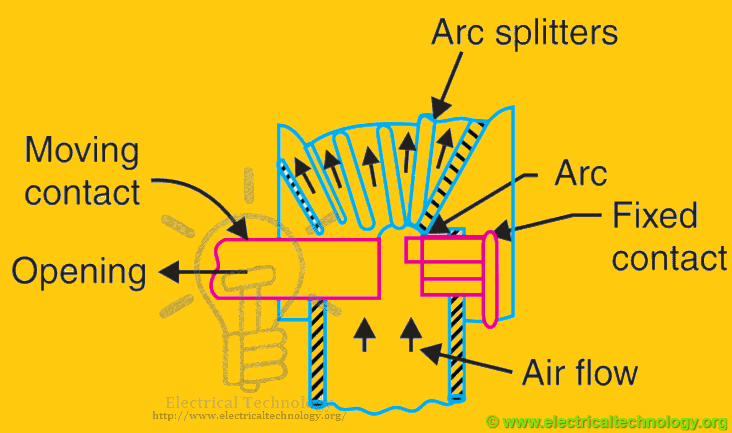
Air blast circuit breaker:
This type of circuit breaker is used for system voltage of 245 KV, 420 KV and even more.
Air blast circuit breaker has further divided into three categories:
- Axial blast breaker
- Axial blast with sliding moving contact.
Axial blast breaker:
The moving contact is in contact. There is a nozzle orifice in fixed contact at normal closed condition of breaker. When a fault occur high pressure is introduced into the chamber. High-pressure air will flow through nozzle orifice voltage is sufficient to sustain.
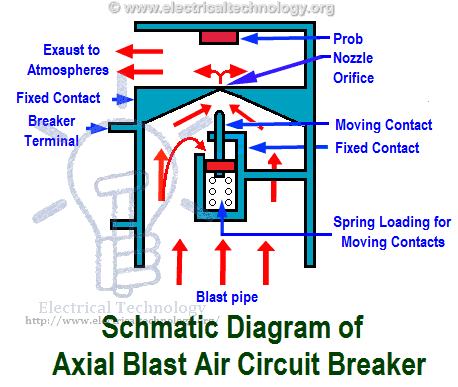
Axial blast with sliding moving contact:
The moving contact is fitted over a piston supported by a spring. The blast transfers arc to arcing electrode.
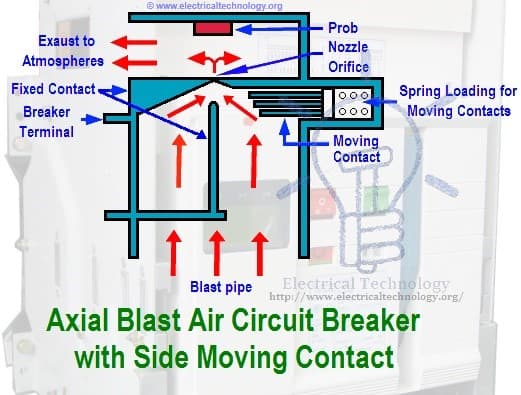
Advantages of Air-Blast Circuit Beaker
- Air blast circuit breaker is a suitable option to use where frequent operation is required because of lesser arc energy
- The risk of fire is eliminated in the operation of Air blast circuit breaker.
- Air blast circuit breaker is small in size, because of the growth of dielectric strength is so rapid (which final contact gap needed for arc extinction is very small).
- Speed of circuit breaker is much higher during operation of the air blast.
- Arc quenching is much faster
- The duration of the arc is same for all values of current.
- Stability of operation can be maintained and depends on speed operation of circuit breakers.
- It requires less maintenance.
Disadvantages of Air-Blast Circuit Breaker
- The air supplier plant requires additional maintenance.
- It contains high capacity air compressor.
- There is a chance of air pressure leakage from the air pipes junction.
- There is chance of a high rate rise of re-striking voltage and current chopping.
- The air has relatively lower arc extinguishing properties.
Application and Uses of Air Circuit Breaker:
- It is used for protection of plants
- It is used for common protection of electrical machines
- It used for protection of transformers, capacitors and generators.
- Air circuit breaker is also used in Electricity sharing system and NGD about 15kV
- Also used in Low as well as High voltage and Currents applications .


